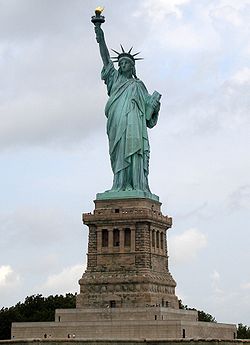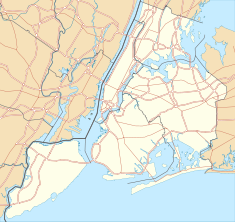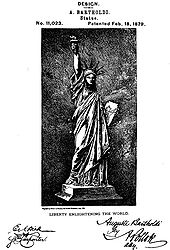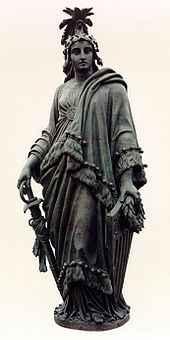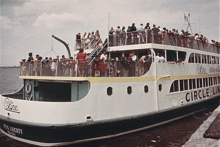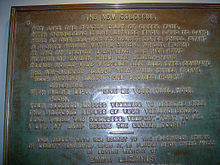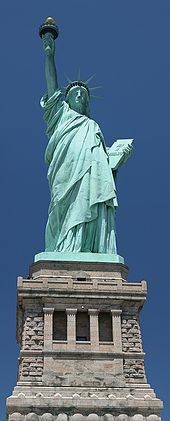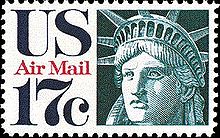- Statue of Liberty
-
For other uses, see Statue of Liberty (disambiguation).
Statue of Liberty Location: Liberty Island
New York City, New York, U.S.[1]Coordinates: 40°41′21″N 74°2′40″W / 40.68917°N 74.04444°WCoordinates: 40°41′21″N 74°2′40″W / 40.68917°N 74.04444°W Height: 151 feet 1 inch (46 meters)
Ground to torch: 305 feet 1 inch (93 meters)Dedicated: October 28, 1886 Restored: 1938, 1984–1986, 2011–2012 (ongoing) Sculptor: Frédéric Auguste Bartholdi Visitation: 3.2 million (in 2009[2]) Governing body: U.S. National Park Service UNESCO World Heritage Site Type: Cultural Criteria: i, vi Designated: 1984 (8th session) Reference #: 307 State Party:  United States
United StatesRegion: Europe and North America U.S. National Register of Historic Places Official name: Statue of Liberty National Monument, Ellis Island and Liberty Island Designated: October 15, 1966[3] Reference #: 66000058 U.S. National Monument Designated: October 15, 1924 Designated by: President Calvin Coolidge[4] New York City Landmark Type: Individual Designated: September 14, 1976[5] Location of Statue of Liberty in New York HarborThe Statue of Liberty (Liberty Enlightening the World; French: La Liberté éclairant le monde) is a colossal neoclassical sculpture on Liberty Island in New York Harbor, designed by Frédéric Bartholdi and dedicated on October 28, 1886. The statue, a gift to the United States from the people of France, is of a robed female figure representing Libertas, the Roman goddess of freedom, who bears a torch and a tabula ansata (a tablet evoking the law) upon which is inscribed the date of the American Declaration of Independence, July 4, 1776. A broken chain lies at her feet. The statue has become an icon of freedom and of the United States.
Bartholdi was inspired by French law professor, politician, and anti-slavery activist Édouard René de Laboulaye, who commented in 1865 that any monument raised to American independence would properly be a joint project of the French and American peoples. Due to the troubled political situation in France, work on the statue did not commence until the early 1870s. In 1875, Laboulaye proposed that the French finance the statue and the Americans provide the pedestal and the site. Bartholdi completed the head and the torch-bearing arm before the statue was fully designed, and these pieces were exhibited for publicity at international expositions. The arm was displayed at the Centennial Exposition in 1876 and in New York's Madison Square Park from 1876 to 1882. Fundraising proved difficult, especially for the Americans, and by 1885 work on the pedestal was threatened due to lack of funds. Publisher Joseph Pulitzer of the World started a drive for donations to complete the project that attracted more than 120,000 contributors, most of whom gave less than a dollar. The statue was constructed in France, shipped overseas in crates, and assembled on the completed pedestal on what was then called Bedloe's Island. The statue's completion was marked by New York's first ticker-tape parade and a dedication ceremony presided over by President Grover Cleveland.
The statue was administered by the United States Lighthouse Board until 1901 and then by the Department of War; since 1933 it has been maintained by the National Park Service. The statue was closed for renovation for much of 1938. In the early 1980s, it was found to have deteriorated to such an extent that a major restoration was required. While the statue was closed from 1984 to 1986, the torch and a large part of the internal structure were replaced. After the September 11 attacks in 2001, it was closed for reasons of safety and security; the pedestal reopened in 2004 and the statue in 2009, with limits on the number of visitors allowed to ascend to the crown. The statue, including the pedestal and base, closed beginning on October 29, 2011 for up to a year, so that a secondary staircase and other safety features can be installed; Liberty Island remains open. Public access to the balcony surrounding the torch has been barred for safety reasons since 1916.
Contents
Design and construction
Origin
The origin of the Statue of Liberty project is generally traced to a comment made by French law professor and politician Édouard René de Laboulaye in mid-1865. In after-dinner conversation at his home near Versailles, Laboulaye, an ardent supporter of the Union in the American Civil War, stated: "If a monument should rise in the United States, as a memorial to their independence, I should think it only natural if it were built by united effort—a common work of both our nations."[6]
Laboulaye's comment was not intended as a proposal, but it inspired a young sculptor, Frédéric Bartholdi, who was present at the dinner.[6] Given the repressive nature of the regime of Napoleon III, Bartholdi took no immediate action on the idea except to discuss it with Laboulaye. Instead, Bartholdi approached Ismail Pasha, Khedive of Egypt, with a plan to build a huge lighthouse in the form of an ancient Egyptian female fellah or peasant, robed and holding a torch aloft, at the northern entrance to the Suez Canal in Port Said. Sketches and models were made of the proposed work, though it was never erected. There was a classical precedent for the Suez proposal, the Colossus of Rhodes: an ancient bronze statue of the Greek god of the sun, Helios. This statue is believed to have been over 100 feet (30 m) high, and it similarly stood at a harbor entrance and carried a light to guide ships.[7]
The American project was further delayed by the Franco-Prussian War, in which Bartholdi served as a major of militia.[6] In the war, Napoleon III was captured and deposed. Bartholdi's home province of Alsace was lost to the Prussians, and a more liberal republic was installed in France.[6] As Bartholdi had been planning a trip to the United States, he and Laboulaye decided the time was right to discuss the idea with influential Americans.[8] In June 1871, Bartholdi crossed the Atlantic, with letters of introduction signed by Laboulaye.[9]
Arriving at New York Harbor, Bartholdi focused on Bedloe's Island as a site for the statue, struck by the fact that vessels arriving in New York had to sail past it. He was delighted to learn that the island was owned by the United States government—it had been ceded by the New York State Legislature in 1800 for harbor defense. It was thus, as he put it in a letter to Laboulaye: "land common to all the states."[10] As well as meeting many influential New Yorkers, Bartholdi visited President Ulysses S. Grant, who assured him that it would not be difficult to obtain the site for the statue.[11] Bartholdi crossed the United States twice by rail, and met many Americans whom he felt would be sympathetic to the project.[9] But he remained concerned that popular opinion on both sides of the Atlantic was insufficiently supportive of the proposal, and he and Laboulaye decided to wait before mounting a public campaign.[12]
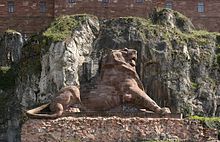 Bartholdi's Lion of Belfort
Bartholdi's Lion of Belfort
Bartholdi had made a first model of his concept in 1870.[13] The son of a friend of Bartholdi's, American artist John La Farge, later maintained that Bartholdi made the first sketches for the statue during his U.S. visit at La Farge's Rhode Island studio. Bartholdi continued to develop the concept following his return to France.[13] He also worked on a number of sculptures designed to bolster French patriotism after the defeat by the Prussians. One of these was the Lion of Belfort, a monumental sculpture carved in sandstone below the fortress of Belfort, which during the war had resisted a Prussian siege for over three months. The defiant lion, 73 feet (22 m) long and half that in height, displays an emotional quality characteristic of Romanticism, which Bartholdi would later bring to the Statue of Liberty.[14]
Design, style, and symbolism
 Detail from a fresco by Constantino Brumidi in the U.S. Capitol in Washington, D.C., showing two early symbols of America: Columbia (left) and the Indian princess
Detail from a fresco by Constantino Brumidi in the U.S. Capitol in Washington, D.C., showing two early symbols of America: Columbia (left) and the Indian princess
Bartholdi and Laboulaye considered how best to express the idea of American liberty.[15] In early American history, two female figures were frequently used as cultural symbols of the nation.[16] One, Columbia, was seen as an embodiment of the United States in the manner that Britannia was identified with the United Kingdom and Marianne came to represent France. Columbia had supplanted the earlier figure of an Indian princess, which had come to be regarded as uncivilized and derogatory toward Americans.[16] The other significant female icon in American culture was a representation of Liberty, derived from Libertas, the goddess of freedom widely worshipped in ancient Rome, especially among emancipated slaves. A Liberty figure adorned most American coins of the time,[15] and representations of Liberty appeared in popular and civic art, including Thomas Crawford's Statue of Freedom (1863) atop the dome of the United States Capitol Building.[15]
Artists of the 18th and 19th centuries striving to evoke republican ideals commonly used representations of Liberty.[15] A figure of Liberty was also depicted on the Great Seal of France.[15] However, Bartholdi and Laboulaye avoided an image of revolutionary liberty such as that depicted in Eugène Delacroix's famed Liberty Leading the People (1830). In this painting, which commemorates France's Revolution of 1830, a half-clothed Liberty leads an armed mob over the bodies of the fallen.[16] Laboulaye had no sympathy for revolution, and so Bartholdi's figure would be fully dressed in flowing robes.[16] Instead of the impression of violence in the Delacroix work, Bartholdi wished to give the statue a peaceful appearance and chose a torch, representing progress, for the figure to hold.[3]
Crawford's statue was designed in the early 1850s. It was originally to be crowned with a pileus, the cap given to emancipated slaves in ancient Rome. Secretary of War Jefferson Davis, a Southerner who would later serve as president of the Confederate States of America, was concerned that the pileus would be taken as an abolitionist symbol. He ordered that it be changed to a helmet.[17] Delacroix's figure wears a pileus,[16] and Bartholdi at first considered placing one on his figure as well. Instead, he used a diadem, or crown, to top its head.[18] In so doing, he avoided a reference to Marianne, who invariably wears a pileus.[19] The seven rays form a halo or aureole.[20] They evoke the sun, the seven seas, and the seven continents,[21] and represent another means, besides the torch, whereby Liberty enlightens the world.[3]
Bartholdi's early models were all similar in concept: a female figure in neoclassical style representing liberty, wearing a stola and pella (gown and cloak, common in depictions of Roman goddesses) and holding a torch aloft. The face was modeled after that of Charlotte Beysser Bartholdi, the sculptor's mother.[22] He designed the figure with a strong, uncomplicated silhouette, which would be set off well by its dramatic harbor placement and allow passengers on vessels entering New York Bay to experience a changing perspective on the statue as they proceeded toward Manhattan. He gave it bold classical contours and applied simplified modeling, reflecting the huge scale of the project and its solemn purpose.[3] Bartholdi wrote of his technique:
The surfaces should be broad and simple, defined by a bold and clear design, accentuated in the important places. The enlargement of the details or their multiplicity is to be feared. By exaggerating the forms, in order to render them more clearly visible, or by enriching them with details, we would destroy the proportion of the work. Finally, the model, like the design, should have a summarized character, such as one would give to a rapid sketch. Only it is necessary that this character should be the product of volition and study, and that the artist, concentrating his knowledge, should find the form and the line in its greatest simplicity.[23]
Bartholdi made alterations in the design as the project evolved. Bartholdi considered having Liberty hold a broken chain, but decided this would be too divisive in the days after the Civil War. The erected statue does rise over a broken chain, half-hidden by her robes and difficult to see from the ground.[18] Bartholdi was initially uncertain of what to place in Liberty's left hand; he settled on a tabula ansata, a keystone-shaped tablet[24] used to evoke the concept of law.[25] Though Bartholdi greatly admired the United States Constitution, he chose to inscribe "JULY IV MDCCLXXVI" on the tablet, thus associating the date of the country's Declaration of Independence with the concept of liberty.[24]
Consultations with the metalwork foundry Gaget, Gauthier & Co. led Bartholdi to conclude that the skin should be made of copper sheets, beaten to shape by the repoussé method.[26] An advantage of this choice was that the entire statue would be light for its volume—the copper need be only .094 inches (2.4 mm) thick. He decided on a height of 151 feet (46 m) for the statue, double that of Italy's Colosso di San Carlo Borromeo and the German statue of Arminius, both made with the same method.[27] Bartholdi interested a former teacher of his, architect Eugène Viollet-le-Duc, in the project. Viollet-le-Duc planned to construct a brick pier within the statue, to which the skin would be anchored.[28]
Announcement and early work
In 1875, France was enjoying improved political stability and a recovering postwar economy. Growing interest in the upcoming Centennial Exhibition in Philadelphia led Laboulaye to decide it was time to seek public support.[29] In September 1875, he announced the project and the formation of the Franco-American Union as its fundraising arm. With the announcement, the statue was given a name, Liberty Enlightening the World.[30] The French would finance the statue; Americans would be expected to pay for the pedestal.[31] The announcement provoked a generally favorable reaction in France, though many Frenchmen resented the United States for not coming to their aid during the war with Prussia.[30] French monarchists opposed the statue, if for no other reason than it was proposed by the liberal Laboulaye, who had recently been elected a senator for life.[31] Laboulaye arranged events designed to appeal to the rich and powerful, including a special performance at the Paris Opera on April 25, 1876, that featured a new cantata by composer Charles Gounod. The piece was titled La Liberté éclairant le monde, the French version of the statue's announced name.[30]
 Stereoscopic image of right arm and torch of the Statue of Liberty, 1876 Centennial Exposition
Stereoscopic image of right arm and torch of the Statue of Liberty, 1876 Centennial Exposition
Despite its initial focus on the elites, the Union was successful in raising funds from across French society. Schoolchildren and ordinary citizens gave, as did 181 French municipalities. Laboulaye's political allies supported the call, as did descendants of the French contingent in the American Revolutionary War. Less idealistically, contributions came from those who hoped for American support in the French attempt to build the Panama Canal. The firm of Japy Frères, copper merchants, donated all the copper needed to build the statue, a gift valued at 64,000 francs (about $16,000 at the time or the equivalent of $323,000 today).[32][33] The copper is said to have come from a mine in Visnes, Norway,[34] though this has not been conclusively determined.[35]
Although plans for the statue had not been finalized, Bartholdi moved forward with fabrication of the right arm, bearing the torch, and the head. Work began at the Gaget, Gauthier & Co. workshop.[36] In May 1876, Bartholdi traveled to the United States as a member of a French delegation to the Centennial Exhibition,[37] and arranged for a huge painting of the statue to be shown in New York as part of the Centennial festivities.[38] The arm did not arrive in Philadelphia until August; because of its late arrival, it was not listed in the exhibition catalogue, and while some reports correctly identified the work, others called it the "Colossal Arm" or "Bartholdi Electric Light". The exhibition grounds contained a number of monumental artworks to compete for fairgoers' interest, including an outsized fountain designed by Bartholdi.[39] Nevertheless, the arm proved popular in the exhibition's waning days, and visitors would climb up to the balcony of the torch to view the fairgrounds.[40] After the exhibition closed, the arm was transported to New York, where it remained on display in Madison Square Park for several years before it was returned to France to join the rest of the statue.[40]
During his second trip to the United States, Bartholdi addressed a number of groups about the project, and urged the formation of American committees of the Franco-American Union.[41] Committees to raise money to pay for the foundation and pedestal were formed in New York, Boston, and Philadelphia.[42] The New York group eventually took on most of the responsibility for American fundraising and is often referred to as the "American Committee".[43] One of its members was 19-year-old Theodore Roosevelt, the future governor of New York and president of the United States.[41] On March 3, 1877, on his final full day in office, President Grant signed a joint resolution that authorized the President to accept the statue when it was presented by France and to select a site for it. President Rutherford B. Hayes, who took office the following day, selected the Bedloe's Island site that Bartholdi had proposed.[44]
Construction in France
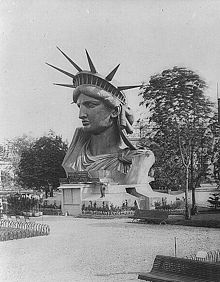 The statue's head on exhibit at the Paris World's Fair, 1878
The statue's head on exhibit at the Paris World's Fair, 1878
On his return to Paris in 1877, Bartholdi concentrated on completing the head, which was exhibited at the 1878 Paris World's Fair. Fundraising continued, with models of the statue put on sale. Tickets to view the construction activity at the Gaget, Gauthier & Co. workshop were also offered.[33] The French government authorized a lottery; among the prizes were valuable silver plate and a terracotta model of the statue. By the end of 1879, about 250,000 francs had been raised.[45]
The head and arm had been built with assistance from Viollet-le-Duc, who fell ill in 1879. He soon died, leaving no indication of how he intended to transition from the copper skin to his proposed masonry pier.[46] The following year, Bartholdi was able to obtain the services of the innovative designer and builder Alexandre-Gustave Eiffel.[33] Eiffel and his structural engineer, Maurice Koechlin, decided to abandon the pier and instead build an iron truss tower. Eiffel opted not to use a completely rigid structure, which would force stresses to accumulate in the skin and lead eventually to cracking. To enable the statue to move slightly in the winds of New York Harbor and as the metal expanded on hot summer days, he loosely connected the support structure to the skin using an armature—a metal framework that ends in a mesh of metal straps, known as "saddles", that are riveted to the skin, providing firm support. In a labor-intensive process, each saddle had to be crafted individually.[47] To prevent galvanic corrosion between the copper skin and the iron support structure, Eiffel insulated the skin with asbestos impregnated with shellac.[48] The change in structural material from masonry to iron allowed Bartholdi to change his plans for the statue's assembly. He had originally expected to assemble the skin on-site as the masonry pier was built; instead he decided to build the statue in France and have it disassembled and transported to the United States for reassembly in place on Bedloe's Island.[49]
Eiffel's design made the statue one of the earliest examples of curtain wall construction, in which the exterior of the structure is not load bearing, but is instead supported by an interior framework. He included two interior spiral staircases, to make it easier for visitors to reach the observation point in the crown.[50] Access to an observation platform surrounding the torch was also provided, but the narrowness of the arm allowed for only a single ladder, 40 feet (12 m) long.[51] As the pylon tower arose, Eiffel and Bartholdi coordinated their work carefully so that completed segments of skin would fit exactly on the support structure.[52]
In a symbolic act, the first rivet placed into the skin, fixing a copper plate onto the statue's big toe, was driven by United States Ambassador to France Levi P. Morton.[53] The skin was not, however, crafted in exact sequence from low to high; work proceeded on a number of segments simultaneously in a manner often confusing to visitors.[54] Some work was performed by contractors—one of the fingers was made to Bartholdi's exacting specifications by a coppersmith in the southern French town of Montauban.[55] By 1882, the statue was complete up to the waist, an event Barthodi celebrated by inviting reporters to lunch on a platform built within the statue.[56] Laboulaye died in 1883. He was succeeded as chairman of the French committee by Ferdinand de Lesseps, builder of the Suez Canal. The completed statue was formally presented to Ambassador Morton at a ceremony in Paris on July 4, 1884, and de Lesseps announced that the French government had agreed to pay for its transport to New York.[57] The statue remained intact in Paris pending sufficient progress on the pedestal; by January 1885, this had occurred and the statue was disassembled and crated for its ocean voyage.[58]
Fundraising, criticism, and construction in the United States
The committees in the United States faced great difficulties in obtaining funds. The Panic of 1873 had led to an economic depression that persisted through much of the decade. The Liberty statue project was not the only such undertaking that had difficulty raising money: construction of the obelisk later known as the Washington Monument sometimes stalled for years; it would ultimately take over three-and-a-half decades to complete.[59] There was criticism both of Bartholdi's statue and of the fact that the gift required Americans to foot the bill for the pedestal. In the years following the Civil War, most Americans preferred realistic artworks depicting heroes and events from the nation's history, rather than allegorical works like the Liberty statue.[59] There was also a feeling that Americans should design American public works—the selection of Italian-born Constantino Brumidi to decorate the Capitol had provoked intense criticism, even though he was a naturalized U.S. citizen.[60] Harper's Weekly declared its wish that "M. Bartholdi and our French cousins had 'gone the whole figure' while they were about it, and given us statue and pedestal at once."[61] The New York Times stated that "no true patriot can countenance any such expenditures for bronze females in the present state of our finances."[62] Faced with these criticisms, the American committees took little action for several years.[62]
The foundation of Bartholdi's statue was to be laid inside Fort Wood, a disused army base on Bedloe's Island constructed between 1807 and 1811. Since 1823, it had rarely been used, though during the Civil War, it had served as a recruiting station.[63] The fortifications of the structure were in the shape of an eleven-point star. The statue's foundation and pedestal were aligned so that it would face southeast, greeting ships entering the harbor from the Atlantic Ocean.[64] In 1881, the New York committee commissioned Richard Morris Hunt to design the pedestal. Within months, Hunt submitted a detailed plan, indicating that he expected construction to take about nine months.[65] He proposed a pedestal 114 feet (35 m) in height; faced with money problems, the committee reduced that to 89 feet (27 m).[66]
Hunt's pedestal design contains elements of classical architecture, including Doric portals, and the large mass is fragmented with architectural detail to focus attention on the statue.[66] In form, it is a truncated pyramid, 62 feet (19 m) square at the base and 39.4 feet (12.0 m) at the top. The four sides are identical in appearance. Above the door on each side, there are ten disks upon which Bartholdi proposed to place the coats of arms of the states (between 1876 and 1889, there were 40 U.S. states), although this was not done. Above that, a balcony was placed on each side, framed by pillars. Bartholdi placed an observation platform near the top of the pedestal, above which the statue itself rises.[67] According to author Louis Auchincloss, the pedestal "craggily evokes the power of an ancient Europe over which rises the dominating figure of the Statue of Liberty".[66] The committee hired former army General Charles Pomeroy Stone to oversee the construction work.[68] Construction on the 15-foot (4.6 m) deep foundation began in 1883, and the pedestal's cornerstone was laid in 1884.[65] In Hunt's original conception, the pedestal was to have been made of solid granite. Financial concerns again forced him to revise his plans; the final design called for poured concrete walls, up to 20 feet (6.1 m) thick, faced with granite blocks.[69][70] The concrete mass was the largest poured to that time.[70]
Fundraising for the statue had begun in 1882. The committee organized a large number of money-raising events.[71] As part of one such effort, an auction of art and manuscripts, poet Emma Lazarus was asked to donate an original work. She initially declined, stating she could not write a poem about a statue. At the time, she was also involved in aiding refugees to New York who had fled anti-Semitic pogroms in eastern Europe. These refugees were forced to live in conditions that the wealthy Lazarus had never experienced. She saw a way to express her empathy for these refugees in terms of the statue.[72] The resulting sonnet, "The New Colossus", including the iconic lines "Give me your tired, your poor/Your huddled masses yearning to breathe free", is uniquely identified with the Statue of Liberty and is inscribed on a plaque in the museum in the base.[73]
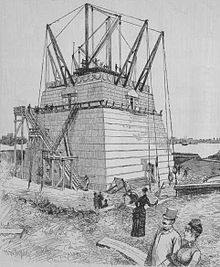 Richard Morris Hunt's pedestal under construction in June 1885
Richard Morris Hunt's pedestal under construction in June 1885
Even with these efforts, fundraising lagged. Grover Cleveland, the governor of New York, vetoed a bill to provide $50,000 for the statue project in 1884. An attempt the next year to have Congress provide $100,000, sufficient to complete the project, failed when Democratic representatives would not agree to the appropriation. The New York committee, with only $3,000 in the bank, suspended work on the pedestal. With the project in jeopardy, groups from other American cities, including Boston and Philadelphia, offered to pay the full cost of erecting the statue in return for relocating it.[74] Joseph Pulitzer, publisher of the World, a New York newspaper, announced a drive to raise $100,000 (the equivalent of $2.3 million today).[32] Pulitzer pledged to print the name of every contributor, no matter how small the amount given.[75] The drive captured the imagination of New Yorkers, especially when Pulitzer began publishing the notes he received from contributors. "A young girl alone in the world" donated "60 cents, the result of self denial."[76] One donor gave "five cents as a poor office boy's mite toward the Pedestal Fund." A group of children sent a dollar as "the money we saved to go to the circus with."[77] Another dollar was given by a "lonely and very aged woman."[76] Residents of a home for alcoholics in New York's rival city of Brooklyn (the cities would not merge until 1898) donated $15; other drinkers helped out through donation boxes in bars and saloons.[78] A kindergarten class in Davenport, Iowa, mailed the World a gift of $1.35.[76]
As the donations flooded in, the committee resumed work on the pedestal.[79] In June, New Yorkers displayed their new-found enthusiasm for the statue, as the French vessel Isère arrived with the crates holding the disassembled statue on board. Two hundred thousand people lined the docks and hundreds of boats put to sea to welcome the Isère.[80] After five months of daily calls to donate to the statue fund, on August 11, 1885, the World announced that $102,000 had been raised from 120,000 donors, and that 80 percent of the total had been received in sums of less than one dollar.[81]
Even with the success of the fund drive, the pedestal was not completed until April 1886. Immediately thereafter, reassembly of the statue began. Eiffel's iron framework was anchored to steel I-beams within the concrete pedestal and assembled.[82] Once this was done, the sections of skin were carefully attached.[83] Due to the width of the pedestal, it was not possible to erect scaffolding, and workers dangled from the armature by ropes while installing the skin sections. Nevertheless, no one died during the construction work.[84] Bartholdi had planned to put floodlights on the torch's balcony to illuminate it; a week before the dedication, the Army Corps of Engineers vetoed the proposal, fearing that ships' pilots passing the statue would be blinded. Instead, Bartholdi cut portholes in the torch (which was covered with gold leaf) and placed the lights inside them.[85] A power plant was installed on the island to light the torch and for other electrical needs.[86] After the skin was completed, renowned landscape architect Frederick Law Olmstead, designer of New York's Central Park and Brooklyn's Prospect Park, supervised a cleanup of Bedloe's Island in anticipation of the dedication.[87]
Dedication
 Unveiling of the Statue of Liberty Enlightening the World (1886) by Edward Moran. Oil on canvas. The J. Clarence Davies Collection, Museum of the City of New York.
Unveiling of the Statue of Liberty Enlightening the World (1886) by Edward Moran. Oil on canvas. The J. Clarence Davies Collection, Museum of the City of New York.
A ceremony of dedication was held on the afternoon of October 28, 1886. President Grover Cleveland, the former New York governor, presided over the event.[88] On the morning of the dedication, a parade was held in New York City; estimates of the number of people who watched it ranged from several hundred thousand to a million. President Cleveland headed the procession, then stood in the reviewing stand to see bands and marchers from across America. General Stone was the grand marshal of the parade. The route began at Madison Square, once the venue for the arm, and proceeded to Battery Park at the southern tip of Manhattan by way of Fifth Avenue and Broadway, with a slight detour so the parade could pass in front of the World building on Park Row. As the parade passed the New York Stock Exchange, traders threw ticker tape from the windows, beginning the New York tradition of the ticker-tape parade.[89]
A nautical parade began at 12:45 p.m., and President Cleveland embarked on a yacht that took him across the harbor to Bedloe's Island for the dedication.[90] De Lesseps made the first speech, on behalf of the French committee, followed by the chairman of the New York committee, Senator William M. Evarts. A French flag draped across the statue's face was to be lowered to unveil the statue at the close of Evarts's speech, but Bartholdi mistook a pause as the conclusion and let the flag fall prematurely. The ensuing cheers put an end to Evarts's address.[89] President Cleveland spoke next, stating that the statue's "stream of light shall pierce the darkness of ignorance and man's oppression until Liberty enlightens the world".[91] Bartholdi, observed near the dais, was called upon to speak, but he refused. Orator Chauncey M. Depew concluded the speechmaking with a lengthy address.[92]
No members of the general public were permitted on the island during the ceremonies, which were reserved entirely for dignitaries. The only females granted access were Bartholdi's wife and de Lesseps's granddaughter; officials stated that they feared women might be injured in the crush of people. The restriction offended area suffragists, who chartered a boat and got as close as they could to the island. The group's leaders made speeches applauding the embodiment of Liberty as a woman and advocating women's right to vote.[91] A scheduled fireworks display was postponed until November 1 because of poor weather.[93]
Shortly after the dedication, the Cleveland Gazette, an African American newspaper, suggested that the statue's torch not be lit until the United States became a free nation "in reality":
"Liberty enlightening the world," indeed! The expression makes us sick. This government is a howling farce. It can not or rather does not protect its citizens within its own borders. Shove the Bartholdi statue, torch and all, into the ocean until the "liberty" of this country is such as to make it possible for an inoffensive and industrious colored man to earn a respectable living for himself and family, without being ku-kluxed, perhaps murdered, his daughter and wife outraged, and his property destroyed. The idea of the "liberty" of this country "enlightening the world," or even Patagonia, is ridiculous in the extreme.[94]
History since dedication
Lighthouse Board and War Department (1886–1933)
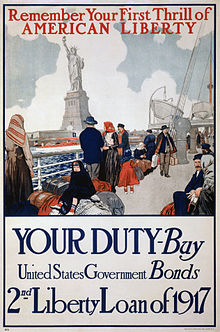 Government poster using the Statue of Liberty to promote the sale of Liberty Bonds
Government poster using the Statue of Liberty to promote the sale of Liberty Bonds
When the torch was illuminated on the evening of the statue's dedication, it produced only a faint gleam, barely visible from Manhattan. The World characterized it as "more like a glowworm than a beacon."[86] Bartholdi suggested gilding the statue to increase its ability to reflect light, but this proved too expensive. The United States Lighthouse Board took over the Statue of Liberty in 1887 and pledged to install equipment to enhance the torch's effect; in spite of its efforts, the statue remained virtually invisible at night. When Bartholdi returned to the United States in 1893, he made additional suggestions, all of which proved ineffective. He did successfully lobby for improved lighting within the statue, allowing visitors to better appreciate Eiffel's design.[86] In 1901, President Theodore Roosevelt, once a member of the New York committee, ordered the statue's transfer to the War Department, as it had proved useless as a lighthouse.[95] A unit of the Army Signal Corps was stationed on Bedloe's Island until 1923, after which military police remained there while the island was under military jurisdiction.[96]
The statue rapidly became a landmark. Many immigrants who entered through New York saw it as a welcoming sight. Oral histories of immigrants record their feelings of exhilaration on first viewing the Statue of Liberty. One immigrant who arrived from Greece recalled,
I saw the Statue of Liberty. And I said to myself, "Lady, you're such a beautiful! [sic] You opened your arms and you get all the foreigners here. Give me a chance to prove that I am worth it, to do something, to be someone in America." And always that statue was on my mind.[97]
Originally, the statue was a dull copper color, but shortly after 1900 a green patina, also called verdigris, caused by the oxidation of the copper skin, began to spread. As early as 1902 it was mentioned in the press; by 1906 it had entirely covered the statue.[98] In the belief that the patina was evidence of corrosion, Congress authorized $62,800 to paint the statue both inside and out.[99] There was considerable public protest against the proposed exterior painting.[100] The Army Corps of Engineers studied the patina for any ill effects to the statue and concluded that it protected the skin, "softened the outlines of the Statue and made it beautiful."[101] The statue was painted only on the inside. The Corps of Engineers also installed an elevator to take visitors from the base to the top of the pedestal.[101]
On July 30, 1916, during World War I, German saboteurs set off a disastrous explosion on the Black Tom peninsula in Jersey City, New Jersey, in what is now part of Liberty State Park, close to Bedloe's Island. Carloads of dynamite and other explosives that were being sent to Britain and France for their war efforts were detonated, and seven people were killed. The statue sustained minor damage, mostly to the torch-bearing right arm, and was closed for ten days. The cost to repair the statue and buildings on the island was about $100,000. The narrow ascent to the torch was closed for public safety reasons, and it has remained closed ever since.[92]
That same year, Ralph Pulitzer, who had succeeded his father Joseph as publisher of the World, began a drive to raise $30,000 for an exterior lighting system to illuminate the statue at night. He claimed over 80,000 contributors but failed to reach the goal. The difference was quietly made up by a gift from a wealthy donor—a fact that was not revealed until 1936. An underwater power cable brought electricity from the mainland and floodlights were placed along the walls of Fort Wood. Gutzon Borglum, who later sculpted Mount Rushmore, redesigned the torch, replacing much of the original copper with stained glass. On December 2, 1916, President Woodrow Wilson pressed the telegraph key that turned on the lights, successfully illuminating the statue.[102]
After the United States entered World War I in 1917, images of the statue were heavily used in both recruitment posters and the Liberty Bond drives that urged American citizens to support the war financially. This impressed upon the public the war's stated purpose—to secure liberty—and served as a reminder that embattled France had given the United States the statue.[103]
In 1924, President Calvin Coolidge used his authority under the Antiquities Act to declare the statue a national monument.[95] The only successful suicide in the statue's history occurred five years later, when a man climbed out of one of the windows in the crown and jumped to his death, glancing off the statue's breast and landing on the base.[104]
Early National Park Service years (1933–1982)
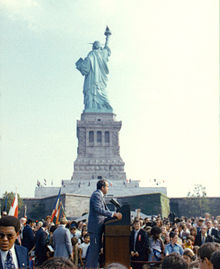 September 26, 1972: President Richard Nixon visits the statue to open the American Museum of Immigration. The statue's raised right foot is visible, showing that it is depicted moving forward.
September 26, 1972: President Richard Nixon visits the statue to open the American Museum of Immigration. The statue's raised right foot is visible, showing that it is depicted moving forward.
In 1933, President Franklin Roosevelt ordered the statue transferred to the National Park Service (NPS). In 1937, the NPS gained jurisdiction over the rest of Bedloe's Island.[95] With the Army's departure, the NPS began to transform the island into a park.[105] The Works Progress Administration (WPA) demolished most of the old buildings, regraded and reseeded the eastern end of the island, and built granite steps for a new public entrance to the statue from its rear. The WPA also carried out restoration work within the statue, temporarily removing the rays from the statue's halo so their rusted supports could be replaced. Rusted cast-iron steps in the pedestal were replaced with new ones made of reinforced concrete;[106] the upper parts of the stairways within the statue were replaced, as well. Copper sheathing was installed to prevent further damage from rainwater that had been seeping into the pedestal.[107] The statue was closed to the public from May until December 1938.[106]
During World War II, the statue remained open to visitors, although it was not illuminated at night due to wartime blackouts. It was lit briefly on December 31, 1943, and on D-Day, June 6, 1944, when its lights flashed "dot-dot-dot-dash," the Morse code for V, for victory. New, powerful lighting was installed in 1944–1945, and beginning on V-E Day, the statue was once again illuminated after sunset. The lighting was for only a few hours each evening, and it was not until 1957 that the statue was illuminated every night, all night.[108] In 1946, the interior of the statue within reach of visitors was coated with a special plastic so that graffiti could be washed away.[107]
In 1956, an act of Congress officially renamed Bedloe's Island as Liberty Island, a change advocated by Bartholdi generations earlier. The act also mentioned the efforts to found an American Museum of Immigration on the island, which backers took as federal approval of the project, though the government was slow to grant funds for it.[109] Nearby Ellis Island was made part of the Statue of Liberty National Monument by proclamation of President Lyndon Johnson in 1965.[95] In 1972, the immigration museum, in the statue's base, was finally opened in a ceremony led by President Richard Nixon. The museum's backers never provided it with an endowment to secure its future and it closed in 1991 after the opening of an immigration museum on Ellis Island.[82]
The statue was several times taken over briefly by demonstrators, publicizing causes such as Puerto Rican independence, opposition to abortion, and opposition to US intervention in Grenada. Demonstrations with the permission of the Park Service included a Gay Pride Parade rally and the annual Captive Baltic Nations rally.[110] A powerful new lighting system was installed in advance of the American Bicentennial in 1976. The statue was the focal point for Operation Sail, a regatta of tall ships from all over the world that entered New York Harbor on July 4, 1976, and sailed around Liberty Island.[111] The day concluded with a spectacular display of fireworks near the statue.[112]
Renovation to present (since 1982)
See also: Liberty Weekend July 4, 1986: First Lady Nancy Reagan (in red) reopens the statue to the public.
July 4, 1986: First Lady Nancy Reagan (in red) reopens the statue to the public.
The statue was examined in great detail by French and American engineers as part of the planning for its centennial in 1986.[113] In 1982, it was announced that the statue was in need of considerable restoration. Careful study had revealed that the right arm had been improperly attached to the main structure. It was swaying more and more when strong winds blew and there was a significant risk of structural failure. In addition, the head had been installed 2 feet (0.61 m) off center, and one of the rays was wearing a hole in the right arm when the statue moved in the wind. The armature structure was badly corroded, and about two percent of the exterior plates needed to be replaced.[114] Although problems with the armature had been recognized as early as 1936, when cast iron replacements for some of the bars had been installed, much of the corrosion had been hidden by layers of paint applied over the years.[115]
In May 1982, President Ronald Reagan announced the formation of the Statue of Liberty–Ellis Island Centennial Commission, led by Chrysler Corporation chair Lee Iacocca, to raise the funds needed to complete the work.[116] Through its fundraising arm, the Statue of Liberty–Ellis Island Foundation, Inc., the group raised more than $350 million in donations.[117] The Statue of Liberty was one of the earliest beneficiaries of a cause marketing campaign. A 1983 promotion advertised that for each purchase made with an American Express card, the company would contribute one cent to the renovation of the statue. The campaign generated contributions of $1.7 million to the restoration project.[118]
In 1984, the statue was closed to the public for the duration of the renovation. Workers erected scaffolding that obscured the statue from view. Liquid nitrogen was used to remove layers of paint that had been applied to the interior of the copper skin over decades, leaving two layers of coal tar, originally applied to plug leaks and prevent corrosion. Blasting with baking soda powder removed the tar without further damaging the copper.[119] The restorers' work was hampered by the asbestos-based substance that Bartholdi had used (ineffectively, as inspections showed) to prevent galvanic corrosion. Workers within the statue had to wear protective gear, dubbed "moon suits", with self-contained breathing circuits.[120] Larger holes in the copper skin were repaired, and new copper was added where necessary.[121] The replacement skin was taken from a copper rooftop at Bell Labs, which had a patina that closely resembled the statue's; in exchange, the laboratory was provided some of the old copper skin for testing.[122] The torch, found to have been leaking water since the 1916 alterations, was replaced with an exact replica of Bartholdi's unaltered torch.[123] Consideration was given to replacing the arm and shoulder; the National Park Service insisted that they be repaired instead.[124]
The entire armature was replaced. The puddled iron bars used by Eiffel were gradually removed. The new bars that attach to the pylon are made of low-carbon corrosion-resistant stainless steel. The bars that now hold the staples next to the skin are made of Ferralium, an alloy that bends slightly and returns to its original shape as the statue moves.[125] To prevent the ray and arm making contact, the ray was realigned by several degrees.[126] The lighting was again replaced—night-time illumination now comes from metal halide lamps that send beams of light to particular parts of the pedestal or statue, showing off various details.[127] Access to the pedestal, which had been through a nondescript entrance built in the 1960s, was renovated to create a wide opening framed by a set of monumental bronze doors with designs symbolic of the renovation.[128] A modern elevator was installed, allowing handicapped access to the observation area of the pedestal.[129] An emergency elevator was installed within the statue, reaching up to the level of the shoulder.[130]
 September 11, 2001: The twin towers of the World Trade Center burn with the Statue of Liberty in the foreground.
September 11, 2001: The twin towers of the World Trade Center burn with the Statue of Liberty in the foreground.
July 3–6, 1986, was designated "Liberty Weekend", marking the centennial of the statue and its reopening. President Reagan presided over the rededication, with French President François Mitterrand in attendance. July 4 saw a reprise of Operation Sail,[131] and the statue was reopened to the public on July 5.[132] In Reagan's dedication speech, he stated, "We are the keepers of the flame of liberty; we hold it high for the world to see."[131]
Following the September 11 attacks, the statue and Liberty Island were immediately closed to the public. The island reopened at the end of 2001, while the pedestal and statue remained off-limits. The pedestal reopened in August 2004,[132] but the National Park Service announced that visitors could not safely be given access to the statue due to the difficulty of evacuation in an emergency. The Park Service adhered to that position through the remainder of the Bush administration.[133] New York Congressman Anthony D. Weiner made the statue's reopening a personal crusade.[134] On May 17, 2009, President Barack Obama's Secretary of the Interior, Ken Salazar, announced that as a "special gift" to America, the statue would be reopened to the public as of July 4, but that only a limited number of people would be permitted to ascend to the crown each day.[133] The statue, including the pedestal and base, closed on October 29, 2011 (the day after celebrations to mark the statue's 125th anniversary), for installation of new elevators and staircases, and to bring other facilities, such as restrooms, up to code. Although the statue is closed to the public for up to a year, Liberty Island remains open.[1][135]
Access and attributes
Location and visiting
The statue is situated in Upper New York Bay on Liberty Island, south of Ellis Island. Both islands were ceded by New York to the federal government in 1800.[136] As agreed in an 1834 compact between New York and New Jersey that set the state border at the bay's midpoint, the original islands remain New York territory despite their location on the New Jersey side of the state line. Land created by reclamation at Ellis is New Jersey territory.[137]
Entrance to the Statue of Liberty National Monument is free, but there is a charge for the ferry service that all visitors must use, as private boats may not dock at the island. A concession was granted in 2007 to Statue Cruises to operate the transportation and ticketing facilities, replacing Circle Line, which had operated the service since 1953.[138] The ferries, which depart from Liberty State Park in Jersey City and Battery Park in Lower Manhattan, also stop at Ellis Island, making a combined trip possible.[139] All ferry riders are subject to security screening, similar to airport procedures, prior to boarding.[140] The statue, pedestal, and base are presently closed for renovation work.[1] When the site is open, visitors intending to enter the statue's base and pedestal must obtain a complimentary museum/pedestal ticket along with their ferry ticket.[25] Those wishing to climb the staircase within the statue to the crown purchase a special ticket, which may be reserved up to a year in advance. A total of 240 people per day are permitted to ascend: ten per group, three groups per hour. Climbers may bring only medication and cameras—lockers are provided for other items—and must undergo a second security screening.[25]
Inscriptions, plaques, and dedications
There are several plaques and dedicatory tablets on or near the Statue of Liberty. A plaque on the copper just under the figure in front declares that it is a colossal statue representing Liberty, designed by Bartholdi and built by the Paris firm of Gaget, Gauthier et Cie (Cie is the French abbreviation analogous to Co.). A presentation tablet, also bearing Bartholdi's name, declares the statue to be a gift from the people of the Republic of France that honors "the Alliance of the two Nations in achieving the Independence of the United States of America and attests their abiding friendship."[141] There is a tablet placed by the New York committee that commemorates the fundraising done to build the pedestal. The cornerstone also bears a plaque placed by the Freemasons.[141]
In 1903, a bronze tablet that bears the text of "The New Colossus" and commemorates Emma Lazarus was presented by friends of the poet. Until the 1986 renovation, it was mounted inside the pedestal; today it resides in the Statue of Liberty Museum in the base. It is accompanied by a tablet given by the Emma Lazarus Commemorative Committee in 1977, celebrating the poet's life.[141]
A group of statues stands at the western end of the island, honoring those closely associated with the Statue of Liberty. Two Americans—Pulitzer and Lazarus—and three Frenchmen—Bartholdi, Laboulaye, and Eiffel—are depicted. They are the work of Maryland sculptor Phillip Ratner.[142]
In 1984, the Statue of Liberty was designated a UNESCO World Heritage Site. The UNESCO "Statement of Significance" describes the statue as a "masterpiece of the human spirit" that "endures as a highly potent symbol—inspiring contemplation, debate and protest—of ideals such as liberty, peace, human rights, abolition of slavery, democracy and opportunity."[143]
Physical characteristics
Feature[64] U.S. Metric Height of copper statue 151 ft 1 in 46 m Foundation of pedestal (ground level) to tip of torch 305 ft 1 in 93 m Heel to top of head 111 ft 1 in 34 m Length of hand 16 ft 5 in 5 m Index finger 8 ft 1 in 2.44 m Circumference at second joint 3 ft 6 in 1.07 m Head from chin to cranium 17 ft 3 in 5.26 m Head thickness from ear to ear 10 ft 0 in 3.05 m Distance across the eye 2 ft 6 in 0.76 m Length of nose 4 ft 6 in 1.48 m Right arm length 42 ft 0 in 12.8 m Right arm greatest thickness 12 ft 0 in 3.66 m Thickness of waist 35 ft 0 in 10.67 m Width of mouth 3 ft 0 in 0.91 m Tablet, length 23 ft 7 in 7.19 m Tablet, width 13 ft 7 in 4.14 m Tablet, thickness 2 ft 0 in 0.61 m Height of pedestal 89 ft 0 in 27.13 m Height of foundation 65 ft 0 in 19.81 m Weight of copper used in statue 60,000 pounds 27.22 metric tonnes Weight of steel used in statue 250,000 pounds 113.4 metric tonnes Total weight of statue 450,000 pounds 204.1 metric tonnes Thickness of copper sheeting 3/32 of an inch 2.4 mm Depictions
Main articles: Statue of Liberty in popular culture and Replicas of the Statue of Liberty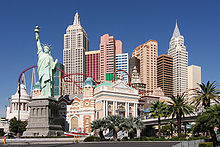 A replica of the Statue of Liberty forms part of the exterior decor at the New York-New York Hotel & Casino in Las Vegas, Nevada.
A replica of the Statue of Liberty forms part of the exterior decor at the New York-New York Hotel & Casino in Las Vegas, Nevada.
Hundreds of replicas of the Statue of Liberty are displayed worldwide.[144] A smaller version of the statue, one-fourth the height of the original, was given by the American community in Paris to that city. It now stands on the Île aux Cygnes, facing west toward her larger sister.[144] A replica 30 feet (9.1 m) tall stood atop the Liberty Warehouse on West 64th Street in Manhattan for many years;[144] it now resides at the Brooklyn Museum.[145] In a patriotic tribute, the Boy Scouts of America, as part of their Strengthen the Arm of Liberty campaign in 1949–1952, donated about two hundred replicas of the statue, made of stamped copper and 100 inches (2,500 mm) in height, to states and municipalities across the United States.[146] Though not a true replica, the statue known as the Goddess of Democracy temporarily erected during the Tiananmen Square protests of 1989 was similarly inspired by French democratic traditions—the sculptors took care to avoid a direct imitation of the Statue of Liberty.[106] Among other recreations of New York City structures, a replica of the statue is part of the exterior of the New York-New York Hotel & Casino in Las Vegas, Nevada.[147]
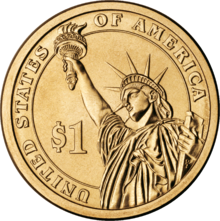 Reverse side of a Presidential Dollar coin
Reverse side of a Presidential Dollar coin
As an American icon, the Statue of Liberty has been depicted on the country's stamps and coinage. It appeared on commemorative coins issued to mark its 1986 centennial, and on New York's 2001 entry in the state quarters series.[148] An image of the statue was chosen for the American Eagle platinum bullion coins in 1997, and it appears on the reverse, or "tails", side of the currently issued series of Presidential Dollar circulating coins.[21] Two images of the statue's torch appear on the current ten-dollar bill.[149] The statue's intended photographic depiction on a 2010 forever stamp proved instead to be of the replica at the Las Vegas casino.[150]
Depictions of the statue have been used by many regional institutions. Between 1986 and 2000, New York State issued license plates featuring the statue.[151][152] The Women's National Basketball Association's New York Liberty use both the statue's name and its image in their logo, in which the torch's flame doubles as a basketball.[153] The New York Rangers of the National Hockey League depicted the statue's head on their third jersey, beginning in 1997.[154] The National Collegiate Athletic Association's 1996 Men's Basketball Final Four, played at New Jersey's Meadowlands Sports Complex, featured the statue in its logo.[155] </ref>
The statue is a frequent subject in popular culture. In music, it has been evoked to indicate support for American policies, as in Toby Keith's song "Courtesy of the Red, White, & Blue (The Angry American)", and in opposition, appearing on the cover of The Dead Kennedys' album Bedtime for Democracy, which protested the Reagan administration's policies.[156] In film, the torch is the setting for the climax of director Alfred Hitchcock's 1942 movie Saboteur.[157] The statue makes one of its most famous cinematic appearances in the 1968 picture Planet of the Apes, in which it is seen half-buried in sand.[156][158] It is destroyed in the science-fiction films Independence Day, The Day After Tomorrow, and Cloverfield.[156] In Jack Finney's time-travel novel Time and Again, the right arm of the statue, on display in the early 1880s in Madison Square Park, plays a crucial role.[159] Robert Holdstock, consulting editor of The Encyclopedia of Science Fiction, wondered in 1979,
Where would [science fiction] be without the Statue of Liberty? For decades it has towered or crumbled above the wastelands of deserted [E]arth—giants have uprooted it, aliens have found it curious ... the symbol of Liberty, of optimism, has become a symbol of science fiction's pessimistic view of the future."[160]
See also
- List of the tallest statues in the United States
- Place des États-Unis
- The Statue of Liberty, Ken Burns documentary
- Statue of Responsibility
- Statues and sculptures in New York City
References
- ^ a b c "Statue of Liberty National Monument". National Park Service. 2007-12-31. http://www.nps.gov/stli/index.htm. Retrieved 2011-10-12.
- ^ Schneiderman, R.M. (2010-06-28). "For tourists, Statue of Liberty is nice, but no Forever 21". The Wall Street Journal. http://blogs.wsj.com/metropolis/2010/06/28/for-tourists-statue-of-liberty-is-no-forever-21/. Retrieved 2011-10-12.
- ^ a b c d National Park Service (1994). National Register of Historic Places, 1966–1994: Cumulative List Through January 1, 1994. Washington DC: National Park Service. p. 502. ISBN 0891332545.
- ^ "National Monument Proclamations under the Antiquities Act". National Park Service. 2003-01-16. http://www.cr.nps.gov/history/hisnps/NPSHistory/monuments.htm. Retrieved 2011-10-12.
- ^ "Statue of Liberty National Monument" (PDF). New York City Landmarks Preservation Commission. September 14, 1976. http://www.neighborhoodpreservationcenter.org/db/bb_files/STATUE-OF-LIBERTY.pdf. Retrieved 2011-10-12.
- ^ a b c d Harris 1985, p. 7.
- ^ Harris 1985, pp. 7–8.
- ^ Khan 2010, pp. 60–61.
- ^ a b Moreno 2000, pp. 39–40.
- ^ Harris 1985, pp. 12–13.
- ^ Khan 2010, pp. 102–103.
- ^ Harris 1985, pp. 16–17.
- ^ a b Khan 2010, p. 85.
- ^ Harris 1985, pp. 10–11.
- ^ a b c d e Sutherland 2003, pp. 17–19.
- ^ a b c d e Bodnar, John (2006). "Monuments and Morals: The Nationalization of Civic Instruction". In Warren, Donald R.; Patrick, John J.. Civic and Moral Learning in America. New York: Macmillan. pp. 212–214. ISBN 1403973962. http://books.google.com/?id=Drhn7XY1WrYC&lpg=PA212&dq=delacroix%20statue%20of%20liberty&pg=PA213#v=onepage&q=delacroix%20statue%20of%20liberty.
- ^ Khan 2010, pp. 96–97.
- ^ a b Khan 2010, pp. 105–108.
- ^ Blume, Mary (2004-07-16). "The French icon Marianne à la mode". The New York Times. http://www.nytimes.com/2004/07/16/style/16iht-blume_ed3_.html. Retrieved 2011-10-12.
- ^ "Get the Facts (Frequently Asked Questions about the Statue of Liberty)". Statue of Liberty. National Park Service. http://www.nps.gov/stli/planyourvisit/get-the-facts.htm. Retrieved 2011-10-19.
- ^ a b "Lady Liberty Reverse Statue of Liberty (1886)". Presidential $1 coin. United States Mint. http://www.usmint.gov/mint_programs/$1coin/?flash=yes&action=reverse. Retrieved 2010-07-29.
- ^ Moreno 2000, pp. 52–53, 55, 87.
- ^ Bartholdi, Frédéric (1885). The Statue of Liberty Enlightening the World. New York: North American Review. p. 42. http://books.google.com/?id=p02VNP45RdsC&dq=pedestal%20statue%20of%20liberty%20hunt&pg=PP6#v=onepage&q=pedestal%20statue%20of%20liberty%20hunt.
- ^ a b Khan 2010, pp. 108–111.
- ^ a b c "Frequently asked questions". Statue of Liberty National Monument. National Park Service. http://www.nps.gov/stli/faqs.htm. Retrieved 2010-08-10.
- ^ Khan 2010, pp. 118, 125.
- ^ Harris 1985, p. 26.
- ^ Khan 2010, p. 120.
- ^ Khan 2010, p. 121.
- ^ a b c Khan 2010, pp. 123–125.
- ^ a b Harris 1985, pp. 44–45.
- ^ a b "Seven Ways to Compute the Relative Value of a U.S. Dollar Amount, 1774 to Present/". Measuringworth. http://www.measuringworth.com/uscompare/result.php?use%5B%5D=DOLLAR&use%5B%5D=GDPDEFLATION&use%5B%5D=VCB&use%5B%5D=UNSKILLED&use%5B%5D=MANCOMP&use%5B%5D=NOMGDPCP&use%5B%5D=NOMINALGDP&year_source=1875&amount=16000&year_result=2009/. Retrieved 2011-10-20. (Consumer price index)
- ^ a b c Khan 2010, p. 137.
- ^ "News of Norway, Issue 4". norway.org. 1999. http://www.norway.org/ARCHIVE/News/archive/1999/199904copper/. Retrieved 2010-07-29.
- ^ "Answers about the Statue of Liberty, Part 2". The New York Times. 2009-07-02. http://cityroom.blogs.nytimes.com/2009/07/02/answers-about-the-statue-of-liberty-part-2/?scp=7&sq=goddess%20of%20democracy%20statue%20of%20liberty&st=cse. Retrieved 2011-10-12.
- ^ Khan 2010, pp. 126–128.
- ^ Bell & Abrams 1984, p. 25.
- ^ Bell & Abrams 1984, p. 26.
- ^ Khan 2010, p. 130.
- ^ a b Harris 1985, p. 49.
- ^ a b Khan 2010, p. 134.
- ^ Bell & Abrams 1984, p. 30.
- ^ Moreno 2000, p. 94.
- ^ Khan 2010, p. 135.
- ^ Bell & Abrams 1984, p. 32.
- ^ Khan 2010, pp. 136–137.
- ^ Khan 2010, pp. 139–143.
- ^ Harris 1985, p. 30.
- ^ Khan 2010, p. 144.
- ^ Harris 1985, p. 33.
- ^ Harris 1985, p. 32.
- ^ Harris 1985, p. 34.
- ^ "Statue of Liberty". pbs.org. http://www.pbs.org/kenburns/statueofliberty/timeline/. Retrieved 2011-10-19.
- ^ Harris 1985, pp. 36–38.
- ^ Harris 1985, p. 39.
- ^ Harris 1985, p. 38.
- ^ Bell & Abrams 1984, p. 37.
- ^ Bell & Abrams 1984, p. 38.
- ^ a b Khan 2010, pp. 159–160.
- ^ Khan 2010, p. 163.
- ^ Khan 2010, p. 161.
- ^ a b Khan 2010, p. 160.
- ^ Moreno 2000, p. 91.
- ^ a b "Statistics". Statue of Liberty. National Park Service. 2006-08-16. http://www.nps.gov/stli/historyculture/statue-statistics.htm. Retrieved 2011-10-19.
- ^ a b Khan 2010, p. 169.
- ^ a b c Auchincloss, Louis (1986-05-12). "Liberty: Building on the Past". New York: 87. http://books.google.com/?id=uuYCAAAAMBAJ&lpg=PA86&dq=pedestal%20statue%20of%20liberty%20hunt%20design&pg=PA87#v=onepage&q=pedestal%20statue%20of%20liberty%20hunt%20design. Retrieved 2011-10-19.
- ^ Bartholdi, Frédéric (1885). The Statue of Liberty Enlightening the World. New York: North American Review. p. 62. http://books.google.com/?id=p02VNP45RdsC&dq=pedestal%20statue%20of%20liberty%20hunt&pg=PP6#v=onepage&q=pedestal%20statue%20of%20liberty%20hunt.
- ^ Harris 1985, pp. 71–72.
- ^ Sutherland 2003, pp. 49–50.
- ^ a b Moreno 2000, pp. 184–186.
- ^ Khan 2010, pp. 163–164.
- ^ Khan 2010, pp. 165–166.
- ^ Moreno 2000, pp. 172–175.
- ^ Levine, Benjamin; Story, Isabelle F. (1961). "Statue of Liberty". National Park Service. http://www.libertystatepark.org/statueofliberty/sol3.shtml. Retrieved 2011-10-19.
- ^ Bell & Abrams 1984, pp. 40–41.
- ^ a b c Harris 1985, p. 105.
- ^ Sutherland 2003, p. 51.
- ^ Harris 1985, p. 107.
- ^ Harris 1985, pp. 110–111.
- ^ Harris 1985, p. 112.
- ^ Harris 1985, p. 114.
- ^ a b Moreno 2000, p. 19.
- ^ Bell & Abrams 1984, p. 49.
- ^ Moreno 2000, p. 64.
- ^ Hayden & Despont 1986, p. 36.
- ^ a b c Harris 1985, pp. 133–134.
- ^ Moreno 2000, p. 65.
- ^ Khan 2010, p. 176.
- ^ a b Khan 2010, pp. 177–178.
- ^ Bell & Abrams 1984, p. 52.
- ^ a b Harris 1985, p. 127.
- ^ a b Moreno 2000, p. 71.
- ^ Harris 1985, p. 128.
- ^ "Postponing Bartholdi's statue until there is liberty for colored as well.". The Cleveland Gazette (Cleveland, Ohio): p. 2. 1886-11-27. http://dbs.ohiohistory.org/africanam/page.cfm?ID=15137. Retrieved 2011-10-19.
- ^ a b c d Moreno 2000, p. 41.
- ^ Moreno 2000, p. 24.
- ^ Sutherland 2003, p. 78.
- ^ "Answers about the Statue of Liberty". City Room. 2009-07-01. http://cityroom.blogs.nytimes.com/2009/07/01/answers-about-the-statue-of-liberty/. Retrieved 2011-10-19.
- ^ "To paint Miss Liberty". The New York Times: p. 1. 1906-07-19. http://query.nytimes.com/gst/abstract.html?res=9D03E0DE143DE433A2575AC1A9619C946797D6CF&scp=2&sq=paint+statue+of+liberty&st=p. Retrieved 2011-10-19.
- ^ "How shall "Miss Liberty"'s toilet be made?". The New York Times: pp. SM2. 1906-07-29. http://query.nytimes.com/gst/abstract.html?res=9F04E6DE1F3EE733A2575AC2A9619C946797D6CF&scp=3&sq=paint+statue+of+liberty&st=p. Retrieved 2011-10-19.
- ^ a b Harris 1985, p. 168.
- ^ Harris 1985, pp. 136–139.
- ^ Moreno 2000, pp. 148–151.
- ^ Harris 1985, p. 147.
- ^ Moreno 2000, p. 136.
- ^ a b c Moreno 2000, p. 202.
- ^ a b Harris 1985, p. 169.
- ^ Harris 1985, pp. 141–143.
- ^ Moreno 2000, pp. 147–148.
- ^ Moreno 2000, pp. 72–73.
- ^ Harris 1985, p. 143.
- ^ Moreno 2000, p. 20.
- ^ Harris 1985, p. 165.
- ^ Harris 1985, pp. 169–171.
- ^ Hayden & Despont 1986, p. 38.
- ^ Moreno 2000, pp. 204–205.
- ^ Moreno 2000, pp. 216–218.
- ^ Daw, Jocelyne (March 2006). Cause Marketing for Nonprofits: Partner for Purpose, Passion, and Profits. Hoboken, NJ: John Wiley & Sons. p. 4. ISBN 9780471717508.
- ^ Hayden & Despont 1986, p. 81.
- ^ Hayden & Despont 1986, p. 76.
- ^ Hayden & Despont 1986, p. 55.
- ^ Harris 1985, p. 172.
- ^ Hayden & Despont 1986, p. 153.
- ^ Hayden & Despont 1986, p. 75.
- ^ Hayden & Despont 1986, pp. 74–76.
- ^ Hayden & Despont 1986, p. 57.
- ^ Moreno 2000, p. 153.
- ^ Hayden & Despont 1986, p. 71.
- ^ Hayden & Despont 1986, p. 84.
- ^ Hayden & Despont 1986, p. 88.
- ^ a b Sutherland 2003, p. 106.
- ^ a b "History and Culture". Statue of Liberty. National Park Service. http://www.nps.gov/stli/historyculture/index.htm. Retrieved 2011-10-20.
- ^ a b Chan, Sewell (2009-05-08). "Statue of Liberty's Crown Will Reopen July 4". The New York Times. http://cityroom.blogs.nytimes.com/2009/05/08/statue-of-libertys-crown-will-reopen-july-4/. Retrieved 2011-10-20.
- ^ Neuman, William (2007-07-05). "Congress to Ask Why Miss Liberty's Crown is Still Closed to Visitors". The New York Times. http://www.nytimes.com/2007/07/05/nyregion/05liberty.html. Retrieved 2011-10-20.
- ^ Raja, Nina (2010-08-10). "Liberty Island to remain open during statue's renovation". CNN. http://www.cnn.com/2011/US/08/10/new.york.liberty.renovation/. Retrieved 2011-10-20.
- ^ "Early History of Bedloe's Island". Statue of Liberty Historical Handbook. National Park Service. http://www.nps.gov/history/history/online_books/hh/11/hh11m.htm. Retrieved 2011-10-20.
- ^ Supreme Court of the United States (1998). "NEW JERSEY v. NEW YORK 523 U.S. 767". http://supreme.justia.com/us/523/767/index.html. Retrieved 2011-10-20.
- ^ Ramirez, Anthony, Anthony (June 29, 2007). "Circle Line Loses Pact for Ferries to Liberty Island". New York Times. http://www.nytimes.com/2007/06/29/nyregion/29ferry.html?pagewanted=print. Retrieved 2011-10-20
- ^ "NPS: Liberty and Ellis Island ferry map". Ferry Map. National Park Service. http://www.nps.gov/stli/planyourvisit/ferry-system-map.htm. Retrieved 2011-10-20.
- ^ "For Your Safety and Security". Statue of Liberty. National Park Service. http://www.nps.gov/stli/planyourvisit/safety-and-security.htm. Retrieved 2011-08-30.
- ^ a b c Moreno 2000, pp. 222–223.
- ^ Harris 1985, p. 163.
- ^ "Statue of Liberty". World Heritage. UNESCO. http://whc.unesco.org/en/list/307. Retrieved 2011-10-20.
- ^ a b c Moreno 2000, pp. 200–201.
- ^ "Collections: American Art: Replica of the Statue of Liberty, from Liberty Storage & Warehouse, 43–47 West 64th Street, NYC". Brooklyn Museum. https://www.brooklynmuseum.org/opencollection/objects/163578/Replica_of_the_Statue_of_Liberty_from_Liberty_Storage__and__Warehouse_43-47_West_64th_Street_NYC. Retrieved 2011-10-20.
- ^ Attoun, Marti (October 2007). "Little Sisters of Liberty". Scouting. http://www.scoutingmagazine.org/issues/0710/d-wwas.html. Retrieved 2010-08-01.
- ^ Goldberger, Paul (1997-01-15). "New York-New York, it's a Las Vegas town". The New York Times (New York). http://www.nytimes.com/1997/01/15/nyregion/new-york-new-york-it-s-a-las-vegas-town.html?scp=7&sq=new%20york%20casino%20statue%20of%20liberty&st=cse. Retrieved 2011-10-20.
- ^ "Statue of Liberty postage stamps". Statue of Liberty-Ellis Island Foundation, Inc.. http://www.statueofliberty.org/Statue_of_Liberty_Postage_Stamps.html. Retrieved 2011-10-20.
- ^ "The redesigned $10 note". newmoney.gov. Bureau of Engraving and Printing. http://www.newmoney.gov/currency/10.htm. Retrieved 2011-10-20.
- ^ Severson, Kim; Healey, Matthew (2011-04-14). "This Lady Liberty is a Las Vegas teenager". The New York Times (New York). http://www.nytimes.com/2011/04/15/us/15stamp.html?ref=nyregion. Retrieved 2011-10-20.
- ^ "State to start issuing new license plates July 1". The New York Times (New York). 1986-01-24. http://www.nytimes.com/1986/01/24/nyregion/new-york-to-start-issuing-new-license-plates-july-1.html?scp=3&sq=statue%20of%20liberty%20license%20plates&st=cse. Retrieved 2011-10-20.
- ^ "State license plates to get new look". The New York Times (New York). 2000-01-11. http://www.nytimes.com/2000/01/11/nyregion/state-license-plates-to-get-new-look.html?scp=1&sq=statue%20of%20liberty%20license%20plates&st=cse. Retrieved 2011-10-20.
- ^ "'Liberty' for New York club". The New York Times (New York). 1997-02-14. http://www.nytimes.com/1997/02/14/sports/liberty-for-new-york-club.html?scp=2&sq=%22new%20york%20liberty%22%20statue&st=cse. Retrieved 2011-10-20.
- ^ Lapointe, Joe (1997-01-12). "Lady Liberty laces up at the Garden". The New York Times (New York). http://www.nytimes.com/1997/01/12/sports/lady-liberty-laces-up-at-the-garden.html?scp=1&sq=rangers%20third%20jersey%20statue&st=cse. Retrieved 2011-10-20.
- ^ Sandomir, Richard (1996-03-29). "Final Four: States put aside their rivalry and try a little cooperation". The New York Times (New York). http://www.nytimes.com/1996/03/29/sports/final-four-states-put-aside-their-rivalry-and-try-a-little-cooperation.html?scp=1&sq=1996%20final%20four%20logo%20statue%20liberty&st=cse. Retrieved 2011-10-20.
- ^ a b c Morris, Tracy S.. "The Statue of Liberty in Popular Culture". USA Today. http://traveltips.usatoday.com/statue-liberty-popular-culture-3615.html. Retrieved 2011-10-20.
- ^ Spoto, Donald (1983). The Dark Side of Genius: The Life of Alfred Hitchcock. New York: Ballantine. pp. 262–263. ISBN 0-345-31462-X.
- ^ Greene, Eric; Slotkin, Richard (1998). Planet of the Apes as American myth: race, politics, and popular culture. Middletown, CT: Wesleyan University Press. p. 52. ISBN 0819563293. http://books.google.com/?id=ZyIiApfhWngC&dq=statue+of+liberty+planet+of+the+apes. Retrieved 2011-10-20.
- ^ Darrach, Brad (1970-06-26). "The spy who came in from 1882". Life (New York): p. 16. http://books.google.com/books?id=v1UEAAAAMBAJ&lpg=PA16&dq=statue%20of%20liberty's%20arm%20time%20and%20again&pg=PA16#v=onepage&q=statue%20of%20liberty's%20arm%20time%20and%20again&f=false. Retrieved 2011-10-20.
- ^ Nicholls, Peter (1979). The Encyclopedia of Science Fiction. St Albans, Herts, UK: Granada Publishing Ltd.. p. 14. ISBN 0-586-05380-8.
Bibliography
- Bell, James B.; Abrams, Richard L. (1984). In Search of Liberty: The Story of the Statue of Liberty and Ellis Island. Garden City, N.Y.: Doubleday & Co. ISBN 0-385-19624-5.
- Glassberg, David (2003). "Rethinking the Statue of Liberty:". National Park Service. hdl:2450/678.
- Harris, Jonathan (1985). A Statue for America: The First 100 Years of the Statue of Liberty. New York, N.Y.: Four Winds Press (a division of Macmillan Publishing Company). ISBN 0-02-742730-7.
- Hayden, Richard Seth; Despont, Thierry W. (1986). Restoring the Statue of Liberty. New York, N.Y.: McGraw-Hill Book Company. ISBN 0-07-027326-X.
- Khan, Yasmin Sabina (2010). Enlightening the World: The Creation of the Statue of Liberty. Ithaca, N.Y.: Cornell University Press. ISBN 978-0-8014-4851-5.
- Moreno, Barry (2000). The Statue of Liberty Encyclopedia. New York, N.Y.: Simon & Schuster. ISBN 9780738536897.
- Sutherland, Cara A. (2003). The Statue of Liberty. New York, N.Y.: Barnes & Noble Books. ISBN 9780760738900.
External links
- Statue of Liberty National Monument
- Statue of Liberty at Structurae
- Statue of Liberty-Ellis Island Foundation
- "A Giant's Task – Cleaning Statue of Liberty", Popular Mechanics (February 1932)
Articles related to the Statue of Liberty Lighthouses of New York Ambrose Tower Light · Aunt Phebe Rock Light · Barber's Point Light · Barcelona (Portland Harbor) Light · Blackwell Island Light · Bluff Point Light · Braddock Point Light · Buffalo Light · Buffalo Harbor North and South entrance Lights · Buffalo Harbor South Entrance Light · Buffalo North breakwater East end Light · Buffalo North Breakwater South End Light · Cape Vincent Light · Carleton Island Light · Cedar Island Light · Cold Spring Harbor Light · Coney Island Light · Coxsackie Light · Crossover Island Light · Crown Point Light · Cumberland Head Light · Dunkirk Light · East Charity Shoal Light · Eatons Neck · Elm Tree Beacon Light · Esopus Meadows Light · Execution Rocks Light · Fair Haven Light · Fire Island Light · Fort Niagara Light · Fort Lafayette Light · Fort Tompkins Light · Fort Wadsworth Light · Galloo Island Light · Gardiners Point Island · Horse Island Light · Horton Point Light · Hudson-Athens Light · Huntington Harbor (Lloyd Harbor) Light · Kings Point Light · Latimer Reef Light · Little Gull Island Light · Little Red Lighthouse (Jeffrey's Hook) · Montauk Point Light · Moriches Light · New Dorp Light · North Brother Island Light · North Dumpling Light · Oak Orchard Light · Old Field Point Light · Old Orchard Shoal Light · Ogdensburg Harbor Light · Orient Long Beach Bar Light · Orient Point Light · Oswego Harbor West Pierhead Light · Plattsburgh Beacon Light · Plum Island Light · Point Aux Roches Light · Princes Bay Light · Race Rock Light · Rock Island Light · Romer Shoal Light · Rondout Light · Sands Point Light · Saugerties Light · Selkirk Light · Shinnecock Light · Sodus Outer Light · Sodus Point Light · South Brother Island Channel Range Light · South Buffalo North Side Light · Split Rock Point Light · Staten Island Light · Statue of Liberty · Stepping Stones Light · Stony Point (Henderson) Light · Stony Point Light · Strawberry Island Upper Cut Range Light · Stuyvesant Light · Sunken Meadows Light · Sunken Rock Light · Tarrytown (Sleepy Hollow) Light · Thirty Mile Point Light · (Three) Sisters Island Light · Throgs Neck Light · Tibbetts Point Light · Turkey Point (NY) Light · Watervliet Light · West Point Light · West Bank Light · Whitehall Narrows Light · Whitestone Point LightProtected Areas of New York Federal Eleanor Roosevelt • Home of Franklin D. Roosevelt • Kate Mullany House • Martin Van Buren • Saint Paul's Church • Sagamore Hill • Saratoga National Historical Park • Theodore Roosevelt Birthplace • Theodore Roosevelt Inaugural • Thomas Cole House • Vanderbilt Mansion • Women's Rights National Historical Park
African Burial Ground • Castle Clinton • Federal Hall National Memorial • Fort Stanwix • General Grant National Memorial • Governors Island • Hamilton Grange National Memorial • Statue of Liberty
Appalachian Trail • North Country National Scenic Trail
Amagansett • Conscience Point • Elizabeth A. Morton • Iroquois • Montezuma • Oyster Bay • Sayville • Seatuck • Shawangunk Grasslands • Target Rock • Wallkill River • Wertheim
State Allen H. Treman • Allegany • Amherst • Battle Island • Bayard Cutting Arboretum • Bayswater Point • Bear Mountain • Beaver Island • Beechwood • Belmont Lake • Bethpage • Betty & Wilbur Davis • Big Six Mile Creek • Blauvelt • Bonavista • Bowman Lake • Braddock Bay • Brentwood • Bristol Beach • Brookhaven • Buckhorn Island • Buffalo Harbor • Burnham Point • Buttermilk Falls • Caleb Smith • Camp Hero • Canandaigua Lake • Canoe-Picnic Point • Captree • Catharine Valley Trail • Caumsett • Cayuga Lake • Cedar Island • Cedar Point • Chenango Valley • Cherry Plain • Chimney Bluffs • Chittenango Falls • Clarence Fahnestock • Clark Reservation • Clay Pit Ponds • Cold Spring Harbor • Coles Creek • Conesus Lake • Connetquot River • Crab Island • Croil Island • Cumberland Bay • Darien Lakes • De Veaux Woods • Dean's Cove • Delta Lake • Devil's Hole • Dewolf Point • Donald J. Trump • Earl W. Brydges • Eel Weir • Emma Treadwell Thacher • Empire – Fulton Ferry • Evangola • Fahnestock • Fair Haven Beach • Fillmore Glen • Fort Niagara • Four Mile Creek • Franklin D. Roosevelt • Frenchman Island • Galop Island • Gantry Plaza • Gilbert Lake • Gilgo • Glimmerglass • Golden Hill • Goosepond Mountain • Grafton Lakes • Grass Point • Green Lakes • Hamlin Beach • Harriet Hollister Spencer • Harriman • Haverstraw Beach • Heckscher • Hempstead Lake • High Tor • Highland Lakes • Higley Flow • Hither Hills • Honeoye • Hook Mountain • Hudson Highlands • Hudson River Islands • Hudson River • Hunt's Pond • Iona Island • Irondequoit Bay • Jacques Cartier • James Baird • Jamesport • John Boyd Thacher • Jones Beach • Joseph Davis • Keewaydin • Keuka Lake • Knox Farm • Kring Point • Lake Erie • Lake Superior • Lake Taghkanic • Lakeside Beach • Letchworth • Lock 32 • Lodi Point • Long Island • Long Point - Finger Lakes • Long Point - Thousand Islands • Long Point on Lake Chautauqua • Macomb Reservation • Margaret Lewis Norrie • Mark Twain • Mary Island • Max V. Shaul • Mexico Point • Midway • Mine Kill • Minnewaska • Montauk Downs • Montauk Point • Moreau Lake • Napeague • Newtown Battlefield • Niagara Falls • Nissequogue River • Nyack Beach • Oak Orchard • Ogden Mills & Ruth Livingston Mills • Old Croton Aqueduct • Old Erie Canal • Oquaga Creek • Orient Beach • Peebles Island • Pinnacle • Pixley Falls • Point Au Roche • Reservoir • Riverbank • Robert G. Wehle • Robert H. Treman • Robert Moses - Long Island • Robert Moses - Thousand Islands • Robert V. Riddell • Roberto Clemente • Rockefeller • Rockland Lake • Sampson • Sandy Island Beach • Saratoga Lake • Saratoga Spa • Schodack Island • Schunemunk Mountain • Selkirk Shores • Seneca Lake • Shadmoor • Shaver Pond Nature Center • Silver Lake • Sonnenberg Gardens & Mansion • Southwick Beach • St. Lawrence • State Park at the Fair • Sterling Forest • Steuben Memorial • Stony Brook • Storm King • Sunken Meadow • Taconic Outdoor Education Center • Taconic - Copake Falls Area • Taconic - Rudd Pond Area • Tallman Mountain • Taughannock Falls • Theodore Roosevelt Nature Center • Thompson's Lake • Tioga • Trail View • Valley Stream • Verona Beach • Waterson Point • Watkins Glen • Wellesley Island • Westcott Beach • Whetstone Gulf • Whirlpool • Wildwood • Wilson-Tuscarora • Wonder Lake • Woodlawn Beach
Bennington Battlefield • Caumsett • Clermont • Clinton House • Crailo • Crown Point • Darwin Martin House • Fort Montgomery • Fort Ontario • Ganondagan • Grant Cottage • Herkimer Home • Hyde Hall • John Brown Farm and Gravesite • John Burroughs Memorial (Woodchuck Lodge) • John Hay Homestead • Johnson Hall • Knox's Headquarters • Lorenzo • New Windsor Cantonment • Olana • Old Croton Aqueduct • Old Erie Canal • Old Fort Niagara • Oriskany Battlefield • Philipse Manor Hall • Plantings Fields Arboretum -- Coe Hall Historic House Museum • Sackets Harbor Battlefield • Schoharie Crossing • Schuyler Mansion • Senate House • Sonnenberg Gardens & Mansion • Staatsburgh • Steuben Memorial • Stony Point Battlefield • Walt Whitman Birthplace • Washington's Headquarters
Allen Lake • Altmar • Ambler • Armlin Hill • Arnold Lake • Artic China • Ashland Pinnacle • Baker School House • Bald Mountain • Balsam • Balsam Swamp • Barbour Brook • Basswood • Basswood Pond • Bates • Battenkill • Battle Hill • Beals Pond • Bear Creek • Bear Swamp • Bearpen Mountain • Beartown • Beaver Creek • Beaver Dams • Beaver Flow • Beaver Meadow • Beebe Hill • Berlin • Big Brook • Big Buck • Birdseye Hollow • Black Creek • Blenheim • Bobell • Bombay • Bonaparte's Cave • Boutwell Hill • Boyce Hill • Brasher Falls • Brokenstraw • Brookfield Railroad • Broome • Bryant Hill • Buck Hill • Bucks Brook • Buckton • Bucktooth • Bully Hill • Bumps Creek • Burnt-Rossman Hills • Burnt Hill • Bush Hill • Cadyville • Cairo Lockwood • Calhoun Creek • California Hill • California Road • Cameron Mills • Cameron • Canacadea • Canada Creek • Canaseraga • Cascade Valley • Cat Hollow • Cattaraugus • Catherineville • Catlin • Chalres E. Baker • Charleston • Chateaugay • Chautauqua Gorge • Chenango • Cherry Valley • Chestnut Woods • Cinnamon Lake • Clapper Hollow • Clark Hill • Cliffside • Clinton • Cobb Brook • Cobb Creek State Forest • Cold Creek • Cold Spring Brook • Cole Hill • Columbia Lake • Coon Hollow • Cotton Hill • Cotrell • Coventry • Coyle Hill • Coyote Flats • Crab Hollow • Crary Mills • Cuyler Hill • Daketown • Danby • Dannemora • Decatur • Deer River • Degrasse • Delaware • Depot Hill • Deruyter • Dobbins • Dog Hollow • Donahue Woods • Downerville • Dry Run • Dunkin's Reserve • Dutch Settlement • Dutton Ridge • Earlville • East Branch Fish Creek • East Osceola • East Otto • Edwin Hollow • Edwin Mountain • Eldridge Swamp • Elkdale • English Hill • Exeter • Fall Brook • Fairfield • Farmersville • Featherstonhaugh • Fire Fall • Fish Creek • Five Streams • Flat Rock • Florence Hill • Fort Jackson • Frank E. Jadwin • Franklin • Franklin 10 • Frozen Ocean • Furnace Creek • Gas Springs • Gates Hill • Gee Brook • Genegantslet • Gillies Hill • Glenmeal • Golden Hill • Goose Egg • Gorton Lake • Gould Corners • Groundry Hill • Grafton Lakes • Granger • Grant Powell • Grantville • Greenwood • Greenwood Creek • Griggs Gulf • Hall Island • Hammond Hill • Harris Hill • Harry E Dobbins • Hartwick • Harvey Mountain • Hatch Creek • Hawkins Pond • Hemlock Ridge • Hewitt • Hickok Brook • Hickory Lake • High Flats • High Knob • High Towers • High Woods • Hill Higher • Hiltonville • Hinckley • Hogsback • Honey Hill • Hooker Mountain • Hoxie Gorge • Huckleberry Ridge • Huntersfield • Hunts Pond • Independence River • Indian Pipe • Italy Hill • Jackson Hill • Jenksville • Jersey Hill • Karr Valley Creek • Kasoag • Keeney Swamp • Kennedy • Kerryville • Ketchumville • Kettlebail • Keyserkill • Klipnocky • Klondike • Knapp Station • Lafayetteville • Lake Desolation • Lassellsville • Lebanon • Leonard Hill • Lesser Wilderness • Lincklaen • Lincoln Mountain • Line Brook • Lonesome Bay • Long Pond • Lookout • Lost Nation • Lost Valley • Ludlow Creek • Lutheranville • Lyon Brook • Macomb Reservation • Mad River • Mallet Pond • Maple Hill • Maple Valley • Marisposa • Marsh Pond • McCarthy Hill • McDonough • Meads Creek • Melondy Hill • Michigan Hill • Middle Grove • Milford • Mohawk Springs • Montrose Point • Moon Pond • Morgan Hill • Morrow Mountain • Moss Hill • Mount Hunger • Mount Pisgah • Mount Pleasant • Mount Tom • Mount Washington • Muller Hill • Murphy Hill • Nanticoke Lake • Nelson Swamp • Newfield • New Michigan • Nimham Mountain • Nine Mile Creek • North Harmony • O'Hara • Oak Ridge • Oakley Corners • Ohisa • Onjebonge • Orebud Creek • Orton Hollow • Ossian • Otselic • Otsquago • Otter Creek • Palmer's Pond • Peck Hill • Painter Hill • Panama • Papish Pond • Partridge Run • Patria • Pease Hill • Penn Mountain • Perkins Pond • Petersburg • Phillips Creek • Pigeon Hill • Pigtail Hollow • Pinckney • Pine Hill • Pine Ridge • Pitcher Springs • Pittstown • Plainfield • Plattekill • Pleasant Lake • Plum Bottom • Point Rock • Popple Pond • Potato Hill • Pulpit Rock • R. Milton Hick • Raecher • Rakph Road • Raymondville • Red Brook • Relay • Rensselaer Number 3 • Rensselaerville • Robinson Hollow • Rock City • Rock Creek • Rockwood • Roeliff Jansen Kill • Roosa Gap • Roseboom • Rural Grove • Rush Creek • Saint Lawrence • Saint Regis • Salmon River • Sand Bay • Sand Flats • Sandy Creek • Scott Patent • Sears Pond • Shawangunk • Shindagin Creek • Shindagin Hollow • Silver Hill • Skinner Hill • Skyline Drive • Slader Creek • Snow Bowl • Sodom • Sonyea • Spring Brook • South Bradford • South Hammond • South Hill • South Mountain • South Valley • Southville • Stammer Creek • Steam Mill • Steuben Hill • Stewart • Stissing Mountain • Stockton • Stone Barn • Stone Hill • Stone Store • Stoney Pond • Sugar Hill • Summer Hill • Susquehanna • Swancott Mill • Swift Hill • Taconic Hereford • Taconic Ridge • Tassell Hill • Taylor Creek • Taylor Valley • Terry Mountain • Texas Hill • Texas Hollow • Texas School House • Three Springs • Tibbetts • Titusville Mountain • Tomannex • Toothaker Creek • Tracy Creek • Tri-County • Triangle • Trout Brook • Trout Lake • Trout River • Tug Hill • Tuller Hill • Turkey Hill • Turkey Point • Turkey Ridge • Turnpike • Urbana • Ushers Road • Vandermark • Vernooykill • Wagner Farm • Wassaic • Webster Hill • Wellman • West Branch • West Hill • West Mountain • West Oscela • West Parishville • Whalen • Whaupaunaucau • Whippoorwill Corners • Whiskey Flats • White Pond • Whittacker • Wiley Brook • Windfall Creek • Winona • Wolf Brook • Wolf Lake • Woodhull • Wurtsboro Ridge • Yatesville Falls • Yellow Barn • Yellow Lake
Wild ForestsAldrich • Balsam • Black River • Blackhead • Blue Mountain • Bluestone • Cherry Ridge • Colgate Lake • Cranberry Lake • Crystal Lake • Debar Mountain • Dry Brook • Ferris Lake • Fulton Chain • Grass River • Halcott Mountain • Hammond Pond • Horseshoe • Hunter Mountain • Independence River • Jessup River • Kaaterskill • Lake George • Middle Mountain • Moose River Plains • Overlook Mountain • Phoenica • Raquette Boreal • Saranac Lakes • Sargent Ponds • Shaler Mountain • Shandaken • Sundown • Taylor Pond • Vanderwhacker Mountain • Watson East Triangle • White Hill • Wilcox Lake • Willowemoc • Windham High Peak
Other Nature ConservancyEugene and Agnes Meyer Nature Preserve • Santanoni Preserve • Arthur W. Butler Memorial Sanctuary • Indian Brook Assemblage • Marrion Yarrow Preserve • Mildred E. Grierson Memorial Wildlife Sanctuary • Mount Holly Preserve • Long Pond Preserve • Mianus River Gorge Nature Preserve • Henry Morgenthau Preserve • Mount Holly Sanctuary • Otter Creek Preserve • Uplands Farm Nature Sanctuary • Atlantic Double Dunes • Pine Neck Nature Sanctuary • Long Island Center for Conservation • Ruth Wales Sanctuary • Calverton Ponds • Accabonac Harbor • Peconic Estuary Big Woods Preserve • Mashomack Nature Preserve • Montauk Mountain Preserve • Shadmoor Preserve • Andy Warhol Visual Arts Preserve • Coon Mountain Preserve • Gadway Sandstone Pavement Barrens • Silver Lake Bog Preserve • Spring Pond Bog Preserve • Everton Falls Preserve • Clintonville Pine Barrens • O.D. von Engeln Preserve at Malloryville • El Dorado Beach Preserve • Chaumont Barrens Preserve • Freund Wildlife Sanctuary • Lewis A. Swyer Preserve • Hannacroix Ravine Preserve • Kenrose Preserve • Limestone Rise Preserve • Whitbeck Memorial Grove • Stewart Preserve • Lordsland Conservancy • Nellie Hill Preserve • Pawling Nature Reserve • Roger Perry Memorial Preserve • Thompson Pond and Stissing Mountain Preserve • Schunemunk Mountain Preserve • Sam's Point Preserve • Christman Sanctuary • Lisha Kill Natural Area • Moccasin Kill Sanctuary • Denton Sanctuary • Lower Poultney River and Saddles Preserves • West Branch Preserve
World Heritage Sites in the United States Northeast Independence Hall · Statue of Liberty
Midwest South West Carlsbad Caverns · Chaco Culture · Grand Canyon · Hawaii Volcanoes · Kluane-Wrangell-St. Elias-Glacier Bay-Tatshenshini-Alsek1 · Mesa Verde · Olympic National Park · Pueblo de Taos · Papahānaumokuākea · Redwood · Waterton Glacier International Peace Park1 · Yellowstone · Yosemite
Territories 1 Shared with CanadaPopular visitor attractions in New York City Times Square (35M) • Central Park (20M) • Metropolitan Museum of Art (5.2M) • Statue of Liberty (4.24M) • American Museum of Natural History (4M) • Empire State Building (4M) • Museum of Modern Art (2.67M)
U.S. National Register of Historic Places Topics Lists by states Alabama • Alaska • Arizona • Arkansas • California • Colorado • Connecticut • Delaware • Florida • Georgia • Hawaii • Idaho • Illinois • Indiana • Iowa • Kansas • Kentucky • Louisiana • Maine • Maryland • Massachusetts • Michigan • Minnesota • Mississippi • Missouri • Montana • Nebraska • Nevada • New Hampshire • New Jersey • New Mexico • New York • North Carolina • North Dakota • Ohio • Oklahoma • Oregon • Pennsylvania • Rhode Island • South Carolina • South Dakota • Tennessee • Texas • Utah • Vermont • Virginia • Washington • West Virginia • Wisconsin • WyomingLists by territories Lists by associated states Other Categories:- Statue of Liberty
- 1886 establishments
- 1886 in international relations
- Allegorical sculptures
- Artworks in the collection of the United States National Park Service
- Colossal statues
- France–United States relations
- French architecture
- Historic Civil Engineering Landmarks
- History museums in New York
- History of France
- History of immigration to the United States
- Landmarks in New York City
- Liberty symbols
- Lighthouses on the National Register of Historic Places in New York
- Museums in Manhattan
- National Park Service National Monuments in New York
- National personifications
- National symbols of the United States
- Outdoor sculptures in New York City
- Port of New York and New Jersey
- Richard Morris Hunt buildings
- Visitor attractions in New York City
- World Heritage Sites in the United States
Wikimedia Foundation. 2010.

